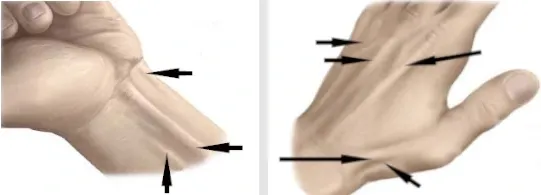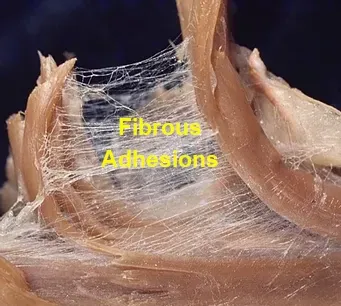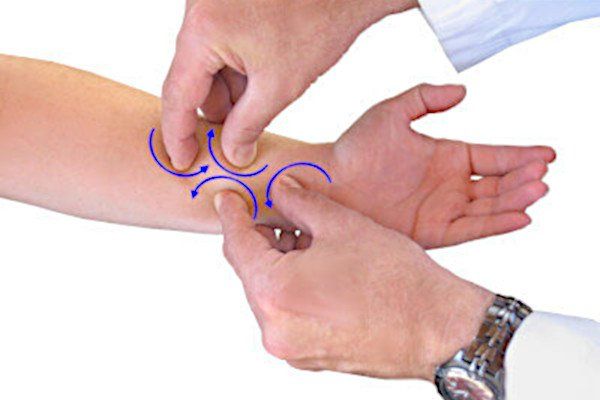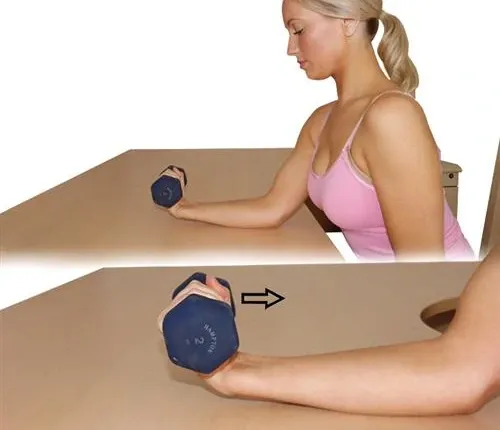Treatment for Wrist Tendonitis
From Dr. Z - Carpal tunnel syndrome specialist
Treatment for Wrist Tendonitis
Treatment for wrist tendonitis is usually a relatively simple and straightforward process. With a little dedication and application of some knowledge, the pain in your fingers, hand, wrist, and forearm can disappear in no time.
But before you begin treatment, be sure you have wrist tendonitis instead of wrist tendinosis or carpal tunnel syndrome. The symptoms are similar, but they're treated differently.
This article shows you how to tell if you have wrist tendonitis, and the best (and fastest) treatment for this painful disorder. But be careful because the symptoms can re-appear if you don't take the proper steps.
Contents of this article:
- What is wrist tendonitis?
- Do you have wrist tendonitis or wrist tendinosis?
- How you get wrist tendonitis and wrist tendinosis
- Treatment for wrist tendonitis
- Treatment for wrist tendinosis
- How to avoid getting wrist tendonitis again
- Summary
What is wrist tendonitis?
Wrist tendonitis (sometimes spelled "tendinitis") is when the tendons in your hand or arm inflame. The inflammation causes pain and other symptoms.
Tendons are ropy structures that attach the muscles in your forearm to your fingers. There are two basic types of tendons of the wrist and hand:
flexors
and
extensors
(see image below). Both types pull on your fingers, but in different directions, causing a different motion.
- Flexor tendons pull and cause the wrist to flex, and the fingers to close or grip. They're located on the palm side of the hand. They also help rotate the wrist.
- Extensor tendons pull and cause the wrist to extend, and the fingers to open. They're located on the back side of the hand. They also help rotate the wrist.
Wrist tendonitis is inflammation of one or more of these tendons. Usually, you will have wrist tendonitis of either the flexor or extensor tendons; rarely both. The more commonly affected tendons are the flexors.
When the tendon inflames, it can cause a number of symptoms. The primary symptom is pain upon moving your fingers. Other symptoms are burning as well as reduced strength and stiffness.
Performing movements like opening and closing your hand or bending or rotating your wrist may cause symptoms. Pain or burning are usually felt when the fingers or hand are moving. At rest, wrist tendonitis usually is not very bothersome.
Do you have wrist tendonitis or wrist tendinosis?
A related condition known as "tendinosis" is much more common than tendonitis. While tendonitis is an acute inflammatory condition, tendinosis is a non-inflammatory chronic condition. Tendinosis is usually mistaken as tendonitis because symptoms are similar (see below). Both tendonitis and tendinosis are included in the umbrella term "tendinopathy".
Symptoms
Symptoms of each condition are similar. Both wrist tendonitis and wrist tendinosis cause pain upon movement. And both conditions can cause burning, as well as reduced strength and stiffness. However, wrist tendonitis pain is usually accompanied by swelling, redness, and a warm feeling. This isn't so with wrist tendinosis.
Both are due to tendon injury
Both wrist tendonitis and wrist tendinosis are usually caused by constant and/or repetitive injury to a finger/hand tendon. If wrist tendonitis becomes chronic it may develop into wrist tendinosis.
- Wrist tendonitis is acute trauma to the hand tendons causing swelling and inflammation.
- In contrast, wrist tendinosis is caused when the hand tendon's collagen fibers degrade. This is due to chronically and repetitively over-using the wrist/finger joint without enough time for it to heal.
Short-term vs long-term tendon injury
Wrist tendonitis and wrist tendinosis are both due to tendon injury. So think of these two conditions like this:
- Tendonitis is a short-term condition. It usually requires a few days of rest to heal.
- Tendinosis is a longer-term condition. It requires 2 or 3 months of rest to heal.
Different treatment goals
It's important to know if you have wrist tendinitis or wrist tendinosis because the treatment goals and healing timelines are different.
- The major treatment goal for wrist tendonitis is to reduce inflammation.
Healing can take several days to weeks, depending on severity.
- The major treatment goals for wrist tendinosis are to
break the cycle of injury and
promote proper collagen placement
in the tendon. Healing can take 2-6 months, depending on severity.
Compare wrist tendonitis & wrist tendinosis
| Comparison Factor | Tendonitis | Tendinosis |
|---|---|---|
| Symptoms | Pain or burning, swelling, redness, warmth | Pain or burning |
| Prevalence | Not common | Extremely common |
| Risk factors | Jobs with intense hand activity, sports, elderly | Jobs with intense hand activity, sports, elderly |
| Recovery time in acute cases | 2-3 days | 2-3 months |
| Recovery time in chronic cases | 4-6 weeks | 3-6 months |
| Long-term outlook (non-surgical) | 99% recover completely with self-care | 80& recover completely with self-care |
How you get wrist tendonitis & wrist tendinosis
Both wrist tendonitis and wrist tendinosis occur with chronic, forceful straining of your wrist, hand or fingers. Certain occupations and activities are infamous for such straining (see below).
Added to this, the older you are, the more prone you are to getting wrist tendonitis or tendinosis. That's because tendons become less flexible with age. Less flexibility makes them more vulnerable to injury.
Not surprisingly, the same occupations also have a high prevalence of
carpal tunnel syndrome. This related disorder is also due to tendon strain.
The occupations and activities which have the highest risk for wrist tendonitis and wrist tendinosis are those which require:
- Rapid or repetitive motions (typists, dental hygienists, cahiers)
- Awkward hand positions (guitar players, carpenters, hairdressers)
- Frequent overhead reaching (stock clerks, electricians, painters)
- Vibration (stonemasons, road workers, truck drivers)
- Forceful exertion (furniture movers, laborers, construction workers)
Certain sports are also associated with a high risk for wrist tendonitis or wrist tendinosis. Most of these sports require forceful, repetitive hand movements. The condition is usually made worse if you're a beginner, when you have not developed optimal technique. The most commonly associated high risk sports are:
- Golf
- Baseball
- Bowling
- Running
- Swimming
- Tennis
- Basketball
Treatment for wrist tendonitis
Once again, the goal of treatment for wrist tendonitis is to relieve pain and lessen inflammation. This usually can be accomplished by the patient, and at home. Most often, patients merely require rest, over-the-counter pain relievers, and mild massage to relieve wrist tendonitis for good.
Rest
Rest is nature's great healer. And one of the greatest treatments for wrist tendonitis is plain old rest.
While it may be nearly impossible to
not
use your hands for a couple days (or weeks), you can certainly cut back on straining them. You can reduce hand strain by:
- Taking frequent rest periods when strenuously using your hands
- Finding alternate ways to perform the same task without applying undue strain to your hands
Both of these methods will allow your hand to rest without significantly cutting into your work time.
Pain medicines
Since the major symptom of wrist tendonitis is pain, pain relievers can be very useful. Over-the-counter medicines like non-steroidal anti-inflammatory drugs (NSAIDs) are usually recommended by doctors. These include acetaminophen (Tylenol), ibuprofen (Advil, Motrin), naproxen (Aleve) or aspirin. All can be quite effective for short-term pain relief.
The above drugs should not be taken chronically (more than 10-12 days). That's because there are potential serious side effects. They include increased chances of heart attack or stroke.
Topical anti-inflammatory creams are also effective. And they don't have the potential side effects of the above oral medicines.
Stretching exercises
At it's source, wrist tendonitis involves microscopic adhesions on the tendon's surface. The adhesions restrict movement and cause inflammation. Therefore, one of the best treatments for wrist tendonitis is a regimen of stretching exercises. These exercises stretch the tendon, which helps break up the adhesions.
The most effective of these stretching exercises target the flexor tendons from the fingertips to the forearm. Interestingly, doctors also recommend these identical
stretches for carpal tunnel syndrome.
Massage
The reason stretches are an effective treatment for wrist tendonitis also applies to massage. Massaging the adhesions tends to break them apart. Doing so loosens fibrous restrictions and allows the tendons to move freely.
The best type of massage is a deep tissue technique called myofascial release. While excellent as a treatment for wrist tendonitis, it's difficult or impossible to perform this treatment on yourself. A partner is required to use their thumbs to make rotational, kneading motions on the flexor tendon surface of your forearm (see image above).
Most often, myofascial release massage provides rapid results. Usually, a few days to weeks (depending on severity) of daily myofascial release massage is sufficient to relieve wrist tendonitis symptoms completely.
Steroid injections
Your doctor may recommend injection of steroid (corticosteroid) into your wrist or forearm as a treatment for wrist tendonitis. Usually, injections are reserved for only severe cases.
The steroid helps reduce inflammation and thus, the pain associated with wrist tendonitis. Steroid injections are not recommended for wrist tendonitis that's chronic (lasting over 3 months). That's because corticosteroids can weaken a tendon, thereby increasing the risk of tendon rupture.
Platelet-rich plasma
In more chronic of severe cases of wrist tendonitis, platelet-rich plasma (or PRP) can be used. This treatment for wrist tendonitis requires taking some of your own blood and separating platelets and other factors that are important in the healing process.
The final solution is injected in the area of your tendon. While effective, this therapy is relatively new, and not yet adopted by many doctors.
Treatment for wrist tendinosis
Treating wrist tendinosis is a little more complicated than the treatment for wrist tendonitis. Once again, the treatment goal of wrist tendinosis focuses on breaking the cycle of injury. It also focuses on promoting proper collagen placement in the tendon tissues.
Rest
While rest is the great healer, some people (especially those with less severe wrist tendinosis) find resting their hand or arm quite difficult in their busy lives. Therefore, breaking the cycle of injury is challenging. But here's what you can do.
If you perform repetitive tasks with your hands, find the time to take frequent mini-rest breaks. The recommended rest schedule is 1 minute of rest for every 15 minutes of repetitive hand stress. More severe symptoms will require more rest time.
And be aware of your own healing process. If a hand activity is causing you pain, it means you're likely doing too much of it.
Ergonomics
As a treatment for wrist tendinosis, "small is big" when it comes to ergonomics. Small changes in the way you use your hands makes a big change to the biomechanics of the strain.
For instance, using a simple wrist rest when typing can alleviate forearm tendon strain. Also, using proper keyboarding techniques to lessen the strain on your fingers is a huge benefit. Try to use an ergonomic keyboard and/or mouse to ease hand and finger strain.
Finally, pay close attention to your posture. Whether you're sitting or standing, your posture determines how much strain your hands ultimately feel. You may want to consult a physical therapist. These professionals are trained to recognize and adjust your posture which may be causing the wrist tendinosis.
Stretching exercises
As with the treatment for wrist tendonitis, treating wrist tendinosis is also greatly enhanced with stretching exercises. However with wrist tendinosis, the stretches should be lighter and should not go beyond the finger or wrist joint's natural range of motion.
Stretching also enhances blood flow. This is particularly important with wrist tendinosis. That's because the added circulation brings in nutrients to the tendon that are important to the long-term healing process. Circulation also helps eliminate cellular debris as new collagen replaces worn out components of the tendon.
Eccentric strengthening
Eccentric strengthening requires you to lengthen a muscle while it's loaded and contracting. For instance, this is accomplished by holding a weight in your hand while slowly flexing your wrist joint. This process stimulates the production of collagen. It also improves how collagen is aligned in the tendon, which helps improve it's strength.
Doctors recommend a regimen of eccentric strengthening for wrist tendinosis that includes 1 or 2 daily sessions. Slowly flex your wrist while holding a weight (e.g., dumb-bell) several times. The key is to flex "slowly", several times per session.
Massage
As with treating wrist tendonitis, a great wrist tendinosis treatment is myofascial release massage. Adhesions and restrictions are reduced, which relieves long-term tension on the tendon.
Yet myofascial release massage has another benefit in the treatment for wrist tendinosis. It assists in resetting muscle memory to a longer baseline state. This further reduces tension on the tendon during activity. The result is less pain and a greater opportunity for the tendon to heal.
Nutrition
Collagen production requires vitamin C, zinc, and manganese. Vitamins B6 and E are also necessary for a tendon's good health.
This is why most doctors advocate proper nutrition and supplementation for patients with wrist tendinosis. But not all doctors agree. Some say the contribution of vitamins and minerals are minor compared to the benefits of the other treatments listed above.
Summary
The treatment for wrist tendonitis and wrist tendinosis is slightly different. Wrist tendonitis is a more acute condition involving inflammation. Wrist tendinosis is a more long-term condition, involving continuous damage and repair of the tendon. Treating wrist tendonitis requires reducing inflammation. Treating wrist tendinosis requires breaking the cycle of tendon injury and repair. To accomplish these goals, both conditions require rest, stretching exercises and myofascial release massage.












